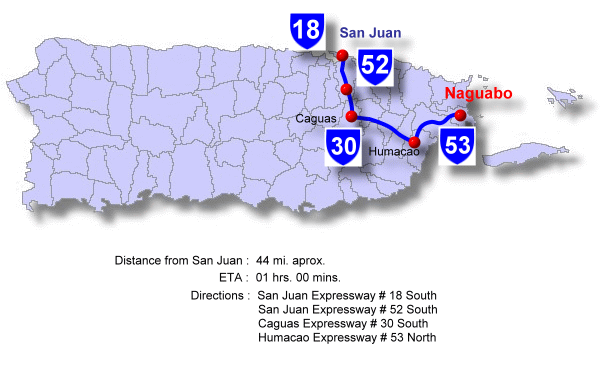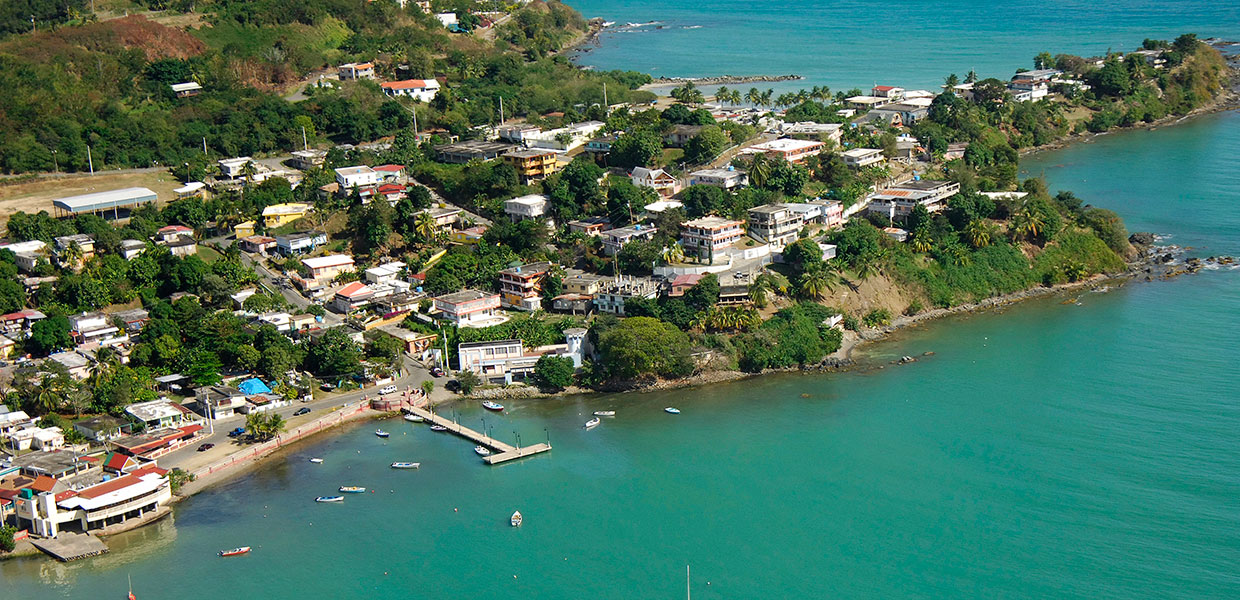
Naguabo, Puerto Rico
Birthplace of Great Artists
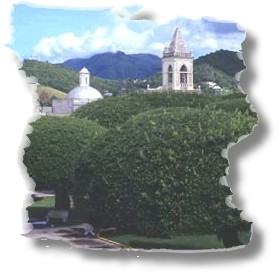
Naguabo (nah-GWAH-bo) is known as the “Birthplace of Great Artists”, “land crab town”, “the town of the land crab eaters”, and “the quiet town”. The patron saint`s festival is held in honor of Our Lady of the Rosary around October 7 of each year. Homage is also given to Our Lady of Mount Carmel, the patroness of fishermen, on July 17, on the coasts of Naguabo.
Naguabo is located on the east coast and east coast of Puerto Rico. It is bordered on the north by Río Grande and Ceiba, by Humacao and the Vieques passage on the south, Ceiba and the Vieques passage on the east, and Las Piedras on the west.
Topographically it is part of the eastern coastal valley region, where the Naguabovalley is located. The soil is largely alluvial soil, brought down by the different streams descending from the mountains.
Tourist attractions are Punta Húcares and the Tropical Beach public beach, where there are many restaurants and housing developments. There is a promenade along the coast where many festivals are held. Visitors and residents alike also bathe in the Blanco and Daguao rivers.
The economy is based on agriculture, including coffee and fruits and vegetables such as plantains, bananas and root vegetables. The dairy industry and cattle are also used to produce meat. Pork and fowl are raised, and there is a fishing industry. There are about a dozen factories, principally producing electrical and electronic devices, light steel, pipes, women`s clothing, and other products.
Naguabo has small deposits of minerals such as copper, iron, and gold.
Foundation:
Naguabo was founded July 15, 1821 near the mouth of the Daguao river with the intention to defend the area from the Caribe Indians.
In 1794 at the request of several influential neighbors of the Spanish Crown, the foundation of Naguabo begins, in a sector known as Pueblo Viejo.
On January 9, 1798 the erection of the Naguabo parish was authorized. In 1841 the construction of the church began. The work concluded in 1856, when it was blessed.
The name of Naguabo originates from the cacique and chieftainship named Daguao. All this territory was very populated by Taíno Indians. When the discovery of the Island took place this region had been visited by Caribe Indian expeditions that already had conquered the Smaller Antilles and continued moving west.
At the end of the 19th century a full-scale sugar mill was established (1894), and as the 20th century began, there were further advances including two other sugar mills (1901 and 1917), an aqueduct (1910), electric power (1914), a public hospital, a modern town hall, schools (1917) an other works. Although the town saw significant progress, in 1912 a large part of the settlement was burnt to the ground in a devastating fire. The town hall was only finally finished in 1924.
Location:
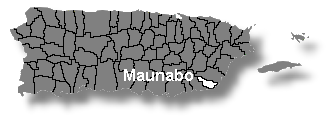 Naguabo is located in the east side of the island. It borders north with the Río Grande and Ceiba, south with Humacao and the Passage of Vieques, west with Las Piedras and east with Ceiba and the Passage of Vieques.
Naguabo is located in the east side of the island. It borders north with the Río Grande and Ceiba, south with Humacao and the Passage of Vieques, west with Las Piedras and east with Ceiba and the Passage of Vieques.
Area:
135.2 sq km / 52.0 sq mi
Population:
23,753 (census 2000)
Population Density:
175.6 per sq km / 456.7 per sq mi
People are known as:
Naguabeños
Naguabo is also known as:
Cuna de Grandes Artistas (Birthplace of Great Artists)
Los Enchumbaos (The Soaked Ones)
Wards: Naguabo, Puerto Rico
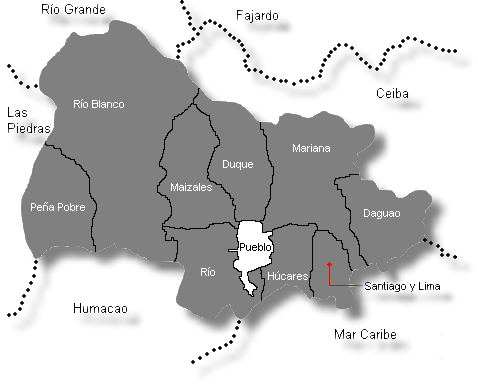
| Census 2000: Population by Wards – Naguabo |
Habitants |
| Daguao | 2,186 |
| Duque | 2,705 |
| Húcares | 2,118 |
| Maizales | 2,120 |
| Mariana | 1,726 |
| Naguabo Pueblo | 1,852 |
| Peña Pobre | 3,872 |
| Río | 3,010 |
| Río Blanco | 3,235 |
| Santiago y Lima | 929 |
| Total | 23,753 |
Source: Censo 2000
Patron:
Virgen del Rosario
Virgen del Rosario Parish
Apartado 665
Naguabo, P.R. 00718
(787) 874-2235

Topography:
It is located in the Regional area of the Southeast. The northern part is within the Luquillo Mountain Range. Within some of its hills are two of greater elevations in this mountain range, the Picos (tips) of the Este and the Oeste, respectively with 1,051 and 1,020 meters (3.448 and 3,346 feet) of altitude above sea level. The rest of the territory of this municipality is level.
Hydrography:
It is bathed by the Daguao, Santiago, Blanco (Naguabo), Cubuy, Sabana, Icacos and Prieto rivers and the Peña Pobre, Sonadora, Vaca, Maizales, Palma, Plátano, and Botija gorges.
Economy:
Agriculture; sugar cane, cattle & fruits and the manufacture of clothing.
Average Salary:
$258.35 weekly (1998)
Flag:
 It is of rectangular shape, celestial blue and to the center the Coat of Arms of Naguabo, which description followings:
It is of rectangular shape, celestial blue and to the center the Coat of Arms of Naguabo, which description followings:
- The color blue is the main color of the shield and symbolizes the sky of Puerto Rico.
- The gold crown symbolizes Cacique Naguabo from whom the region derives its name.
- The silver waves symbolize the sea that bathes the coasts.
- The red border on which appears a broken silver chain means, courage and battles fought with blood; everything which symbolizes the first rise of slaves that took place here and nowhere else in the Island.
- The silver broken chain symbolize the desire of freedom of the insurgents.
- The silver crossed machetes symbolize the pact made by the slave Vaguey to get rid of the oppression of the colonists.
- The black handles of the Machetes symbolize pain, silence and death of the insurgents.
- The gold palms symbolize the wealth of the plantations.
- The gold three – tower crown symbolizes the category of city that characterizes Naguabo.
Coat Of Arms:
 Shield of rectangular form, round off in its inferior part, stamped with a three tower crown mural and adorned with two palms and a banner at its base.
Shield of rectangular form, round off in its inferior part, stamped with a three tower crown mural and adorned with two palms and a banner at its base.
The blue is the main color of the shield and symbolizes the sky of Puerto Rico, this color stands for the virtue, justice, sweetness, beauty, nobility, perseverance, vigilance, recreation, fervor and loyalty of its children. The gold crown symbolizes Cacique Naguabo from whom this region derives its name, this color stands for justice, benignancy, mercy, nobility, generosity, splendor, sovereignty, love, health and prosperity. The silver waves symbolize the sea that bathes the coasts of the region from which derives great part of the wealth of its inhabitants: this color (can be considered also as white) stands for innocence, happiness, purity, temperance, fairness, frankness, eloquence and victory without spilling the blood of the enemy.
The red border on which appears a broken silver chain stands for the courage and battles fought with blood; everything which symbolizes the first rise of slaves that took place here and nowhere else in the Island. The silver broken chain symbolizes the insurgents’ desire for freedom. The silver crossed machetes symbolize the pact made by the slave Vaguey to get rid of the oppression of the colonists. The black handles of the machetes symbolize pain, silence and death of the insurgents. The gold palms symbolize the wealth of the plantations. The gold three – tower crown symbolizes the category of city that characterizes Naguabo.
Events:
- Pedro Flores Week – March
- Festival del Chapín – June
- Diplo Festival – June
- Festival in Honor of Our Lady of Mount Carmel – July
- Patron Saint’s Festival – October
Places To Visit:
- El Yunque National Forest
- Algodones Key
- Centro Yudelmi
- Monument to Ramón Rivero “Diplo”
Playas:
- Naguabo Beach
- La Fanduca Beach
- Punta Lima Beach
- Tropical Beach
Distinguished Citizens:
- Carmen Delia Dipini – Singer and composer.
- Plácido Figueroa – Folksinger who uses the décima espinela and poet.
- Pedro Flores – Prolific composer of Puerto Rican popular music, in New York he founded the Flores Sextet in 1926. His best known compositions include Bajo un palmar, Obsesión, Amor perdido, Ciego amor, Despedida, Margot, Perdón, Sin bandera, Venganza, and Se vende una casita.
- Fernando Gallego – Attorney, judge and poet.
- Matías González García – Journalist, short-story writer and novelist. His works include a novel, Carmela, and stories, “Cosas de antaño,” and “Cosas de ogaño”.
- Ramón López – Poet.
- Inés María Mendoza (widow of Muñoz Marín) – Essayist and educator.
- Ramón Ortiz del Rivero “Diplo”– Famous comedian, actor, writer, and composer, he worked in the theater, radio, films, and television. He was best known as a “black face” character.
- Joaquín R. Parrilla – Poet.
- Pedro Carlos Timothe Morales – Attorney, educator, short story writer, essayist, and textbook writers.
Naguabo public schools.
Naguabo District
| Name | Nivel | Telphone | Address |
| EUGENIO BRAC | ELEMENTAL | (787) 874-3295 | PO Box 550 |
| FAUSTINO R FUERTES | ELEMENTAL | (787) 874-0420 | PO Box 655 |
| JOSÉ R AGOSTO | ELEMENTAL | (787) 874-0080 | PO Box 1267 |
| LUTGARDA RIVERA REYES | ELEMENTAL | (787) 874-0010 | HC 1 Box 4405B |
| LYDIA M LÓPEZ | ELEMENTAL | (787) 874-2908 | PO Box 4693A |
| MAIZALES | ELEMENTAL | (787) 874-0205 | PO Box 4168A |
| QUEBRADA GRANDE | ELEMENTAL | (787) 874-0430 | PO Box 508 |
| FIDELINA MELÉNDEZ MONSANTO | INTERMEDIO | (787) 874-3315 | PO Box 638 |
| ANTONIO RÍOS | SEGUNDA UNIDAD | (787) 874-2005 | PO Box 610 |
| FERMÍN DELGADO | SEGUNDA UNIDAD | (787) 874-0090 | HC 1 Box 4871J |
| SILVERIO GARCÍA | SEGUNDA UNIDAD | (787) 874-5520 | PO Box 639 |
| JUAN JOSÉ MAUNEZ | SUPERIOR | (787) 874-2155 | PO Box 128 |
Hymn:
Hacia el este de las Islas Antillanas,
desde el mar a la montaña fue creando,
el más bello de los pueblos de Borinquen,
al que Dios canta una nana en su regazo.
Quiso Dios bendecir a mi Naguabo con la tierra,
con los bosques, con las fuentes, y su mar,
bello espejo del oriente,
donde el cielo jugueteaba al arrebor.
Mi Naguabo del querer, Mi Naguabo del soñar
por tus calles me crié y tu plaza fue mi hogar.
Mi Naguabo del querer, Mi Naguabo del soñar
por tus calles me crié y tu plaza fue mi hogar.
Es mi orgullo, es un honor ser de Naguabo.
Es mi cuna del Terruño Borinqueño.
¡Qué feliz haber nacido en este pueblo
y que bueno es sentirse naguabeño!

